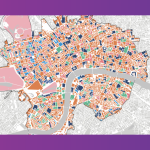The very first in this series of Political Profiles featured the then-Leader of Islington Council, Richard Watts. There’s been a lot of change at Islington since then, not least of which is that Watts was succeeded by Cllr Kaya Comer-Schwartz as Leader. Some things, however, have remained constant. Throughout this period Cllr Diarmaid Ward, the subject of today’s interview, has remained at the heart of borough’s political leadership and responsible for crucial aspects of its work in the wider built environment.
Ward has been an elected councillor since 2014 and a member of Islington’s Executive since 2016, when was assigned the sensitive Housing and Development brief, covering “all aspects of housing management, operations, repairs, and ownership for 38,000 tenants and 12,000 leaseholders on our estate” as well as its housing development programme.
In 2021, he relinquished housing, but retained responsibility for delivering new affordable homes, plus the briefs of Deputy Leader, and of Executive Member for Finance, Planning and Performance. These days, finance is very much on his mind: “I am very pleased that we just passed our budget, under difficult circumstances,” he mentions early on in our discussion. The interview as a whole underlined that the financial needs of the borough and its residents are central to his thinking across all of his many portfolios.
On planning, he says, “we keep things very simple at Islington: jobs, housing, cost of living and climate change, and the net zero carbon challenge – bread and butter issues for everybody.” He adds that he is “very proud” of Islington’s planning record, and is upfront about the fact that the borough’s approach to new development “is very tough – and unapologetically so.” He is at pains to explain that this toughness is not gratuitous. That stance is broadly consistent with the positions put forth by Richard Watts in our interview back in 2021, indicating that the borough has found no reason to change tack.
Commercially-minded
Turning to Islington’s town centres, Ward notes that he represents Holloway ward, which extends from Holloway Road, a significant high street in its own right, right up to the boundary with Camden. He believes that the so-called “death of the town centre is greatly exaggerated” arguing that it will continue to “have a huge place in the future.” He admits, however, to being “very concerned about permitted development rights,” especially those enabling changes from office to residential. “I don’t think this is the way to go at all, it threatens small businesses and circumvents the planning system.” Ultimately, he says, “we don’t want to be a dormitory borough, we want to be a place where people can live, work and thrive.”
The discussion naturally brings us to commercial development and here too, he says, the borough is “tough” though he says “my door is always open, to anybody who wants to talk to us about commercial development – particularly in the CAZ. At the top of our agenda for any such discussion is social value and particularly how we can get local people into good jobs and good careers. If you say your development is providing jobs, we will want to know how many will go to people from local council estates, how many local young people will get an opportunity, how many small local businesses will benefit from affordable workspace, and whether you will provide space for makers, light manufacturing, or creative ideas.”
Ward notes that his colleague Cllr Santiago Bell-Bradford, the Executive Member for Inclusive Economy and Jobs, is a key stakeholder when it comes to commercial planning, jobs, small business and the local economy generally.
Looking to “Islington’s bit of the CAZ” specifically, Ward notes that Old Street, whilst most famous as the Silicon Roundabout tech cluster, also includes “quite a few council estates, close knit communities that have been there for 50, 60, 70 years or more – and while the area is always changing, we want to make sure that those communities remain an integral part of it.”
At the heart of that area lies a development that Ward points to as “an example of good development in the CAZ, in terms of social value.” Derwent London’s White Collar Factory, just off the Old Street roundabout, is home to affordable workspace now run by TownSq Islington on behalf of the council. A local resident, recruited through the council’s iWork programme, is the manager of the workspace; about 80 people have been supported into starting their own business through programmes hosted by the space; and another 50 disadvantaged people have been helped to get into employment or training by organisations based there, including the Breakthrough social enterprise.
Housing matters
“Housing is a huge issue for us.” Ward says. “We have 14,000 people on our waiting list – many will be homeless or in overcrowded housing.” He articulates the importance of decent affordable housing succinctly: “Having a safe, secure and genuinely affordable home is key to living and thriving. Once a family has it, everything else falls in place. Suddenly the kids have space to do their homework. And the grownups can more easily get and hold a job with a fixed address. That is why it’s such a big part of our priorities.”
The Council is doing its best to deliver the homes needed by residents on both low and medium incomes directly, with plans for 750 new council homes by 2027. But Islington’s budget can only pay for so much. Delivering against a wider target of 1,550 new affordable homes by 2026 necessitates partnering with Registered Providers, as well as using Section 106 agreements to full effect.
“Our planning policy says that 50% of all residential projects of over 10 homes must be genuinely affordable and we are clear about what ‘genuinely affordable’ means. 35% of those must be at social rent, or ‘old school council rent’ as I like to call it, with the rest for intermediate tenures.” Intermediate housing is also a priority, to ensure that Islington is affordable “for those who will never make it onto the housing register, but can’t afford to buy or rent either – particularly key workers like nurses and others on median incomes, such as, dare I say it… local authority planners, all of whom we need to make a borough work.”
He notes that while shared ownership “has traditionally been the intermediate tenure we focused on, even that has become increasingly inaccessible in London,” with the borough now “looking more at London Living Rent, the mayor’s new product, where prices are capped at a third of median salary in a given ward.”
Again, Ward stresses that the borough isn’t talking tough for the heck of it – he genuinely believes that it has no choice: “Local government in England has limited powers, as the UK is one of the most centralised states in Europe. We have Council Tax [a major source of boroughs’ income], but it’s a completely regressive tax and we have no power to change it. We’ve had 10 years of austerity. We have few powers over funding important areas like policing and health. But we do have power over planning and we have to use that to the absolute best of our ability. That is why I’m so passionate about it.”
Finance aside, Ward highlights space as a key constraint in Islington, for both developers and the borough itself: “We are a very small borough, just six square miles and don’t have many large sites for building.” The borough’s own in-house residential development programme is focused on infill, or as he says “turning those dark under crofts of old garages into council homes,” as well as estate improvement projects focused on things like the public realm, lighting and landscaping.
He highlights Holloway prison as “the last major site” for all-new residential development in the borough. While “disappointed” that the prison itself was closed by the Ministry of Justice, he stresses that the council’s job “was to make sure the site was used to local benefit and not just sold off to the highest bidder.” Islington produced a site-specific Supplementary Planning Document, clarifying that any redevelopment plans here would have to deliver 50% genuinely affordable housing, new green space and “honour the legacy of site” as a hub for specialist women’s services. The effort seems to have paid off, as approved plans for the site by Peabody include almost 1,000 homes (60% affordable, of which 42% social), a public park and a 15,000 square metre new women’s building. “I am very, very proud of that” he says.
Ward is emphatic that holding residential development to a high standard is in no way a signal that the borough is opposed to it. “My door is always open, any time of day – or night – to anyone who wants to talk about how we can get more genuinely affordable homes, particularly social rent homes, built here in Islington.”
The big picture
Back to the big picture and across all areas of the borough, “going from grey to green – trying to green as many spaces as possible – is another big priority for us.” Aside from enabling access to the natural environment in an area where private gardens are too-rare, through “creative use of CIL” and other means, Islington is, “by some measures, going to be the sixth most affected local authority area by climate change.” Linked to that, it is “important to minimise car journeys, encourage walking and cycling. As a small inner London borough, we are very well placed to do that” he says, declaring himself “fully on board with the concept of the 15 minute city.”
Asked about his personal philosophy and approach to planning, Ward says: “The power of planning is underestimated, but it has so much relevance to people’s lives and should be used as creatively as possible.” Outside work, he is pursuing a PhD at UCL’s Bartlett School, focusing on a shared housing programme in his native Northern Ireland. He describes it as a “case study to apply to other communities” but also a “case in point about the power of planning to shape communities” before going on to say, “I want to shape communities for the better – and that’s why I’m a councillor.”
This interview was conducted by London Communications Agency on behalf of the London Property Alliance as part of its curation of the monthly Central London
Read more from our London Leaders series here.


